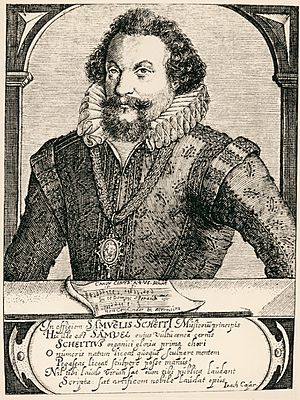Samuel Scheidt facts for kids
Samuel Scheidt (born in 1587, died in 1654) was a German composer, organist, and teacher. He lived during the early Baroque period, a time when music became more dramatic and expressive.
Life and Music Career
Samuel Scheidt was born in a German city called Halle. He started his music studies there. Later, he traveled to Amsterdam to learn from a famous Dutch composer named Sweelinck. Sweelinck's music greatly influenced Scheidt's own style.
When Scheidt returned to Halle, he became the organist for the local ruler, known as the Margrave of Brandenburg. Later, he was promoted to Kapellmeister. This important job meant he was in charge of all the music at the ruler's court.
Unlike many other German musicians, Scheidt stayed in Germany during the Thirty Years' War. This was a very difficult time. He managed to survive by teaching music and taking smaller jobs. Once the war ended and things became stable again, he got his Kapellmeister job back. In 1628, he also became the music director for three churches in Halle, including the important Market Church.
Scheidt was one of the first really important German composers for the organ. He helped create a new style of music in northern Germany. This new style grew partly because of the Protestant Reformation. In southern Germany and other parts of Europe, music was still very much like Italian music. But in the new Protestant areas, musicians were free to create their own unique styles.
Scheidt's music falls into two main types:
- Instrumental music: This includes a lot of music for keyboard instruments, especially the organ.
- Sacred vocal music: This is music for voices, often sung in churches. Some of it was a cappella (sung without instruments). Other pieces used instruments like a basso continuo, which is a bass instrument (like a cello) and a keyboard instrument playing chords.
In his many chorale preludes, Scheidt often used a special technique. He would take a church hymn (a chorale) and create variations on it. Each part of the hymn would have a different rhythm. Each new variation would be more detailed than the last, building up to an exciting part of the music. Besides chorale preludes, he also wrote many fugues (where a musical idea is repeated by different parts), dance suites, and fantasias (free-form musical pieces).
Works
Samuel Scheidt's complete musical works have been published in a large collection of 16 books. You can also find his music in many collections of chorale preludes by different composers.
You can find some of his music for free online:
- Free scores by Samuel Scheidt in the Choral Public Domain Library (ChoralWiki)
- Samuel Scheidt: Free scores at the International Music Score Library Project
See also
 In Spanish: Samuel Scheidt para niños
In Spanish: Samuel Scheidt para niños
- German organ schools


